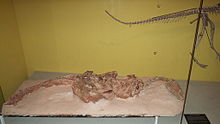Guaibasauridae: Difference between revisions
No edit summary |
No edit summary |
||
| Line 25: | Line 25: | ||
Bonaparte and colleagues (2007) found that guaibasaurids have more characteristics in common with theropods than they do with early sauropodomorphs (or "[[prosauropod]]s"). Because of this, according to Bonaparte, they are most likely either a very basal group on the stem leading toward sauropodomorphs, or a group ancestral to both sauropodomorphs and theropods. Furthermore, the authors interpret this as evidence that the common ancestor of both saurischian lineages was more theropod-like than prosauropod-like.<ref name="bonaparteetal2007"/> |
Bonaparte and colleagues (2007) found that guaibasaurids have more characteristics in common with theropods than they do with early sauropodomorphs (or "[[prosauropod]]s"). Because of this, according to Bonaparte, they are most likely either a very basal group on the stem leading toward sauropodomorphs, or a group ancestral to both sauropodomorphs and theropods. Furthermore, the authors interpret this as evidence that the common ancestor of both saurischian lineages was more theropod-like than prosauropod-like.<ref name="bonaparteetal2007"/> |
||
In 2008, Martin Ezcurra defined the subfamily '''Saturnaliinae''' for the clade containing ''[[Saturnalia (dinosaur)|Saturnalia]]'' and ''[[Chromogisaurus]]'', which were found to be close relatives in several studies.<ref name=ezcura2008>Ezcurra, M. D. (2010). A new early dinosaur (Saurischia: Sauropodomorpha) from the Late Triassic of Argentina: a reassessment of dinosaur origin and phylogeny. Journal of Systematic Palaeontology, 8(3), 371-425.</ref> |
In 2008, Martin Ezcurra defined the subfamily '''Saturnaliinae''' for the clade containing ''[[Saturnalia (dinosaur)|Saturnalia]]'' and ''[[Chromogisaurus]]'', which were found to be close relatives in several studies.<ref name=ezcura2008>Ezcurra, M. D. (2010). A new early dinosaur (Saurischia: Sauropodomorpha) from the Late Triassic of Argentina: a reassessment of dinosaur origin and phylogeny. Journal of Systematic Palaeontology, 8(3), 371-425.</ref> While they are sometimes found to be a subgroup of guaibasaurids, other studies have found the saturnaliines to form an independent lineage at the very base of the sauropodomorph family tree.<ref name=Leyesaurus>{{cite journal |year=2011 |title=A New Basal Sauropodomorph (Dinosauria: Saurischia) from Quebrada del Barro Formation (Marayes-El Carrizal Basin), Northwestern Argentina |url=http://www.plosone.org/article/info%3Adoi%2F10.1371%2Fjournal.pone.0026964 |journal=PLoS ONE |volume=6 |issue=11 |pages=e26964 |doi=10.1371/journal.pone.0026964 |author=Cecilia Apaldetti, Ricardo N. Martinez, Oscar A. Alcober and Diego Pol |editor1-last=Claessens |editor1-first=Leon |pmid=22096511 |pmc=3212523 }}</ref> |
||
==Taxonomy== |
==Taxonomy== |
||
Revision as of 11:56, 6 June 2015
| Guaibasaurids Temporal range: Late Triassic,
| |
|---|---|

| |
| Fossil skeleton of Guaibasaurus candelariensis | |
| Scientific classification | |
| Domain: | Eukaryota |
| Kingdom: | Animalia |
| Phylum: | Chordata |
| Clade: | Dinosauria |
| Clade: | Saurischia |
| Clade: | †Sauropodomorpha |
| Family: | †Guaibasauridae Bonaparte et al., 1999 |
| Type species | |
| †Guaibasaurus candelariensis | |
| Subgroups | |
| |
Guaibasauridae is a family of primitive saurischian dinosaurs, known from fossil remains of late Triassic period formations in Brazil (Paleorrota) and Argentina.
The exact makeup and classification of the Guaibasauridae remains uncertain. The family was originally named by Jose Bonaparte and colleagues in 1999 to contain a single genus and species, Guaibasaurus candelariensis.[1] When a second specimen of Guaibasaurus was described from better remains in 2007, it became easier to compare it to other enigmatic early saurischians, which are often difficult to classify because they combine characteristics of the two major saurischian groups, Theropoda and Sauropodomorpha. Bonaparte and colleagues, in light of the information gained from this second specimen, found that the genus Saturnalia (which is anatomically very similar to Guaibasaurus) could also be assigned to the Guaibasauridae, though they did not conduct a phylogenetic analysis or define Guaibasauridae as a clade. The researchers also tentatively assigned the poorly understood genus Agnosphitys to this family.[2]
Bonaparte and colleagues (2007) found that guaibasaurids have more characteristics in common with theropods than they do with early sauropodomorphs (or "prosauropods"). Because of this, according to Bonaparte, they are most likely either a very basal group on the stem leading toward sauropodomorphs, or a group ancestral to both sauropodomorphs and theropods. Furthermore, the authors interpret this as evidence that the common ancestor of both saurischian lineages was more theropod-like than prosauropod-like.[2]
In 2008, Martin Ezcurra defined the subfamily Saturnaliinae for the clade containing Saturnalia and Chromogisaurus, which were found to be close relatives in several studies.[3] While they are sometimes found to be a subgroup of guaibasaurids, other studies have found the saturnaliines to form an independent lineage at the very base of the sauropodomorph family tree.[4]
Taxonomy
After Ezcurra (2010):[5]
- Suborder Sauropodomorpha
- Family Guaibasauridae

References
- ^ Bonaparte, J.F.; Ferigolo, J.; Ribeiro, A.M. (1999). "A new early Late Triassic saurischian dinosaur from Rio Grandedo Sul State, Brazil." Proceedings of the second Gondwanan Dinosaurs symposium". National Science Museum Monographs, Tokyo. 15: 89–109.
- ^ a b Bonaparte, J.F.; Brea, G.; Schultz, C.L.; Martinelli, A.G. (2007). "A new specimen of Guaibasaurus candelariensis (basal Saurischia) from the Late Triassic Caturrita Formation of southern Brazil". Historical Biology. 19 (1): 73–82. doi:10.1080/08912960600866862.
- ^ Ezcurra, M. D. (2010). A new early dinosaur (Saurischia: Sauropodomorpha) from the Late Triassic of Argentina: a reassessment of dinosaur origin and phylogeny. Journal of Systematic Palaeontology, 8(3), 371-425.
- ^ Cecilia Apaldetti, Ricardo N. Martinez, Oscar A. Alcober and Diego Pol (2011). Claessens, Leon (ed.). "A New Basal Sauropodomorph (Dinosauria: Saurischia) from Quebrada del Barro Formation (Marayes-El Carrizal Basin), Northwestern Argentina". PLoS ONE. 6 (11): e26964. doi:10.1371/journal.pone.0026964. PMC 3212523. PMID 22096511.
{{cite journal}}: CS1 maint: multiple names: authors list (link) CS1 maint: unflagged free DOI (link) - ^ Ezcurra, Martin D. (2010). "A new early dinosaur (Saurischia: Sauropodomorpha) from the Late Triassic of Argentina: a reassessment of dinosaur origin and phylogeny". Journal of Systematic Palaeontology. 8 (3): 371–425. doi:10.1080/14772019.2010.484650.
